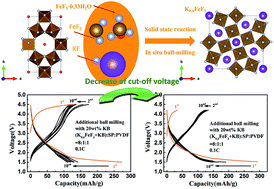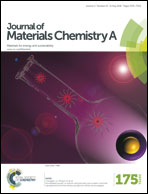Iron-based fluorides of tetragonal tungsten bronze structure as potential cathodes for Na-ion batteries†
Abstract
Room temperature Na-ion batteries (NIBs) are receiving increasing attention owing to their potential application in large-scale stationary energy storage. An open framework strategy has been utilized to construct kinetically favorable Na-ion channels with increased size or dimension, and to alleviate the generation of staged phases and multiphase interfaces during cycling. Here we report a novel open framework iron-based fluoride of tetragonal tungsten bronze (TTB) structure as a potential cathode for NIBs. This tunnel-type fluoride is prepared by topotactically densifying a hexagonal tungsten bronze (HTB) framework with intrinsic corner-sharing FeF6 octahedral chains. K-ions as more robust channel fillers than H2O molecules enable a convenient solid state reaction or mechanochemical synthesis of desired open frameworks moreover at a reduction state. K-stuffed TTB fluoride achieves a favorable electrochemical K extraction with a first charge capacity as high as 125 mA h g−1 and the following reversible Na-storage with a discharge capacity of 100–150 mA h g−1. Structural integrity and near-zero strain sodiation are also responsible for the good cyclability.


 Please wait while we load your content...
Please wait while we load your content...